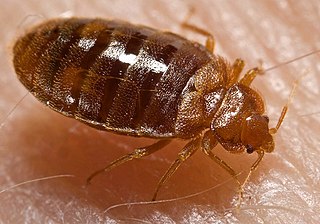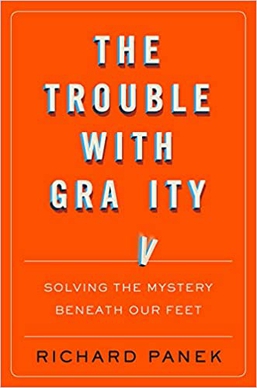
Scientific American, informally abbreviated SciAm or sometimes SA, is an American popular science magazine. Many scientists, including Albert Einstein and Nikola Tesla, have contributed articles to it, with more than 150 Nobel Prize-winners being featured since its inception.

Bed bugs are parasitic insects from the genus Cimex, who are micropredators that feed on blood, usually at night. Their bites can result in a number of health impacts, including skin rashes, psychological effects, and allergic symptoms. Bed bug bites may lead to skin changes ranging from small areas of redness to prominent blisters. Symptoms may take between minutes to days to appear and itchiness is generally present. Some individuals may feel tired or have a fever. Typically, uncovered areas of the body are affected. Their bites are not known to transmit any infectious disease. Complications may rarely include areas of dead skin or vasculitis.

The Cimicidae are a family of small parasitic bugs that feed exclusively on the blood of warm-blooded animals. They are called cimicids or, loosely, bed bugs, though the latter term properly refers to the most well-known member of the family, Cimex lectularius, the common bed bug, and its tropical relation Cimex hemipterus. The family contains over 100 species. Cimicids appeared in the fossil record in the Cretaceous period. When bats evolved in the Eocene, Cimicids switched hosts and now feed mainly on bats or birds. Members of the group have colonised humans on three occasions.

Cimex lectularius, or the common bed bug, is a species of Cimicidae. Its primary hosts are humans, and it is one of the world's major "nuisance pests."

Deborah Leigh Blum is an American science journalist and the director of the Knight Science Journalism program at the Massachusetts Institute of Technology. She is the author of several books, including The Poisoner's Handbook (2010) and The Poison Squad (2018), and has been a columnist for The New York Times and a blogger, via her blog titled Elemental, for Wired.
Bat bugs are parasitic blood-sucking insects that feed primarily on the blood of bats – their hosts. The name has been applied to members of the family Cimicidae and also to members of the family Polyctenidae. Bat bugs are closely related to bed bugs, and are so similar in appearance that they are often mistaken for bed bugs. Microscopic examination is needed to distinguish them. Bat bugs will also bite humans if given the opportunity. Bat bug species include:

Cimex is a genus of insects in the family Cimicidae. Cimex species are ectoparasites that typically feed on the blood of birds and mammals. Two species, Cimex lectularius and Cimex hemipterus, are known as bed bugs and frequently feed on humans, although other species may parasitize humans opportunistically. Species that primarily parasitize bats are known as bat bugs.
Bed bugs occur around the world. Rates of infestations in developed countries, while decreasing from the 1930s to the 1980s, have risen dramatically since the 1980s. Previous to this, they were common in the developing world but rare elsewhere. The increase in the developed world may have been caused by the growth of international travel, resistance to insecticides, and the use of new pest control methods that do not affect bed bugs.

Bed bugs, or Cimicidae, are small parasitic insects. The term usually refers to species that prefer to feed on human blood.
Quanta Magazine is an editorially independent online publication of the Simons Foundation covering developments in physics, mathematics, biology and computer science.
Bedbugs!!! is an American musical comedy about a mad-scientist exterminator named Carly who accidentally mutates New York City's bed bug population with her super-insecticide, which she created out of revenge for her mother's bedbug-related death. The rock musical, written by Paul Leschen (Music) and Fred Sauter, pays homage to 80s rock music, 80s films such as Gremlins and Ghostbusters, and features a side-plot about a Canadian pop singer called Dionne Salon. It opened off-Broadway at the Arclight Theatre on September 14, 2014 and closed on November 2, 2014. It has been compared to The Rocky Horror Show and Little Shop of Horrors.
Undark Magazine is a nonprofit online publication exploring science as a "frequently wondrous, sometimes contentious, and occasionally troubling byproduct of human culture." The name Undark is a deliberate reference to a radium-based luminous paint product called Undark that ultimately proved toxic, if not deadly for those who handled it.

Cimex hemipterus, known as the tropical bed bug, is a species of bed bugs within the family Cimicidae that primarily resides in tropical climates. However, it has been reported that this species can live in more temperate climates along with the closely related bed bug species C. lectularius.C. hemipterus is a hematophagous, obligate parasite of humans. This means that it requires blood meals from their human hosts in order to survive. When bitten, humans experience itchiness, wheals, and lesions around the affected areas on the skin. This species typically resides in human domiciles within cracks, crevices, or mattresses, and are more prevalent in developing countries. Like other bed bugs, C. hemipterus is primarily active during the night time.
Nadja Oertelt is an American science media producer and Chief Content Officer of Science Friday. She is known for her work as a science communicator.
The Open Notebook(TON) is a science journalism non-profit organization, online magazine, and publisher. Its purpose is to help science journalists improve their skills. It publishes articles and interviews on the craft of science writing and maintains a database of successful pitch letters to editors. TON also runs a paid fellowship program for early-career science journalists. The Open Notebook is supported by foundation grants and individual donations, and also partners with journalism and science communication organizations.
Mark E. Siddall is a Canadian biologist and former curator at the American Museum of Natural History. Siddall has studied the evolution and systematics of blood parasites and leeches, and systematic theory. Siddall was hired as an assistant curator at the American Museum of Natural History in July, 1999 and worked there as a curator until September, 2020, when he was terminated for allegedly having violated the museum's policy prohibiting sexual relationships between staff and mentees. Siddall denied the claim.
Emily Conover is an American science journalist, best known for being the only two-time winner of the D.C. Science Writers Association's Newsbrief award. As of 2016, she has been a reporter for American bi-weekly magazine Science News.

The Trouble with Gravity: Solving the Mystery Beneath Our Feet is a nonfiction popular science book by Richard Panek and published by Houghton Mifflin Harcourt on July 9, 2019.

Our Biggest Experiment: An Epic History of the Climate Crisis is a book by British writer Alice Bell, published by Counterpoint in September 2021. Reviewed in Foreign Policy, BuzzFeed News, New Statesman, and Undark Magazine, the book unrolls the history of human concern for weather derangement and climate change along the latest centuries to its present scientific systematization and public prominence.

The 2023 Paris bedbug outbreak was a local infestation of bedbugs that took place in the French capital in the latter half of 2023. Reports of bedbug sightings began in rental and hotel accommodations in the summer of 2023, and escalated to public spaces, including movie theaters and transport systems, over the following months. The outbreak caused national upset and drew significant media attention, with both local and international actors calling on the French government for a more serious response to the situation. This outbreak occurred less than a year before the start of the 2024 Summer Olympics in Paris, raising concerns about the city's ability to safely host tourists and locals traveling for the occasion.








